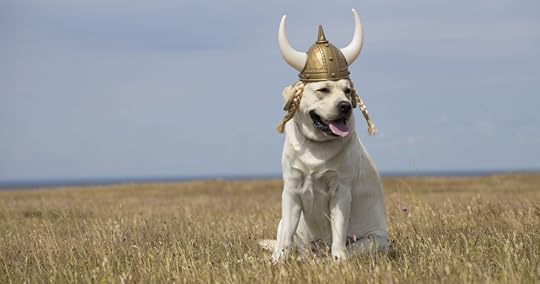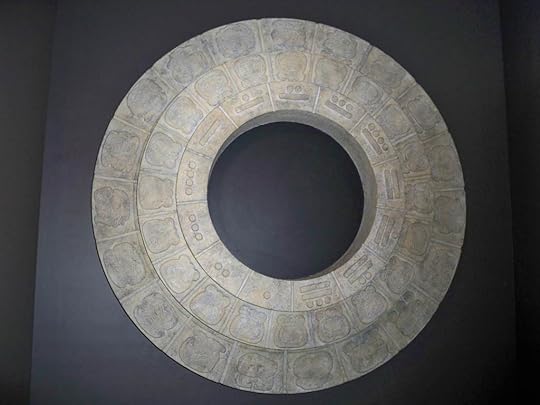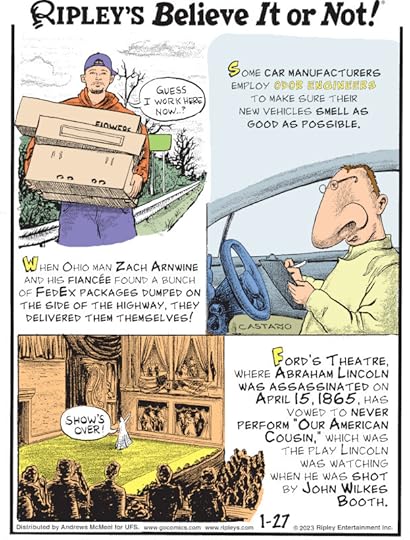Ripley Entertainment Inc.'s Blog, page 43
February 12, 2023
CARTOON 02-12-2023
February 11, 2023
CARTOON 02-11-2023
February 10, 2023
Bones in Viking Burial Grounds Suggest They Loved their Pets
Featured in Ripley's Believe It or Not!

More than 1,000 years ago, Vikings sailed west toward England with their pets onboard their ships, according to a new study published in the journal PLOS One. And when they died, the Vikings built a massive funeral pyre, cremated the animals alongside their human companions, and interred the remains in the same burial mounds.
Together in Life and DeathResearchers examined Heath Wood, a cremation cemetery in central England, and uncovered animal and human remains dating back to the ninth century A.D. The Vikings put the human remains into a giant funeral pyre and set it on fire before raking the remains and removing pieces of bone, lead author Tessi Löffelmann told Live Science. “I find this intriguing because that means there was no clear separation between animals and humans any longer — everything kind of became part of the same thing, something new,” she noted.
What made these cremations particularly interesting was that during that era in England, most people were burying their dead. This would have made the Viking funeral pyres quite a spectacle. They were gigantic, ablaze for several hours, and visible for miles.
Löffelmann noted, “I imagine that this whole event would have lasted well into the night, and the light would likely have been seen from nearby Repton.”
Bountiful Burial MoundsThe Vikings invaded England’s southeastern coast in 865, according to the Anglo-Saxon Chronicle. In the 1940s and 1950s, archaeologists discovered nearly 60 burial mounds in Heath Wood near the village of Repton. They analyzed 20 of the mounds and uncovered swords, shields, and human remains. Researchers also found evidence of sharp force trauma. In one burial mound, they found the remains of an adult and a younger person alongside bones from a dog, horse, and what appeared to be a pig.
Vikings brought their animals to England, research suggests https://t.co/7gfvhOV5Ll
— The Guardian (@guardian) February 1, 2023
The chemical analysis of the bones is notable because it revealed that the animals and one of the adults were not native to England but rather Scandinavia. These findings indicate that the Vikings brought their animals with them to the west. It’s evidence that during the late ninth century people and animals migrated from Scandinavia to England. The animals could have been used for transportation, food, and companionship. There may have also been other types of animals in the burial mounds, but it can be challenging to identify them in cremation graves.
Digging a Little DeeperLöffelmann explained, “I think that the horse and the dog certainly were companions but am less sure about the rest of the animals,” she said. “We know that animals were intricately woven into the mythology of Scandinavia at the time.”
It’s possible that the remains belonged to members of the Viking Great Army; however, Viking archaeologist Cat Jarman, who was not part of the study, told Live Science that Heath Wood radiocarbon dating points to a time period up to the 10th century, which is after the army’s raids, suggesting “an ongoing migration well beyond the historically recorded Great Army movements.”
By Noelle Talmon, contributor for Ripleys.com
EXPLORE THE ODD IN PERSON! Discover hundreds of strange and unusual artifacts and get hands-on with unbelievable interactives when you visit a Ripley’s Odditorium!Source: Bones in Viking Burial Grounds Suggest They Loved their Pets
January 30, 2023
CARTOON 01-30-2023
January 29, 2023
CARTOON 01-29-2023
January 28, 2023
CARTOON 01-28-2023
January 27, 2023
Is Santa Real? 10-Year-Old Gathers DNA Evidence to Find Out
Featured in Ripley's Believe It or Not!

A young girl from the town of Cumberland, Rhode Island, sent a letter to her local police department earlier this month requesting DNA testing on food allegedly eaten by Santa Clause. She wrote, “Dear Cumberland Police Department, I took a sample of a cookie and carrots that I left for Santa and the reindeer on Christmas Eve and was wondering if you could take a sample of DNA and see if Santa is real?”
Keep reading to find out how the officials responded and what they uncovered!
A Detective in the MakingChief Matthew J. Benson alerted the public via Facebook on January 20 that the department had started an investigation into the matter. The “young investigator,” 10-year-old Scarlett Doumato, included a partially eaten Oreo cookie and carrot remnants from the morning of December 25, 2022, and she asked for an analysis to see if the items contained any DNA from St. Nick and/or his reindeer, according to the Washington Post. The Cumberland Investigative Division sent the half-eaten items to the state’s Department of Health Forensic Sciences Unit.
“This young lady obviously has a keen sense for truth and the investigative process and did a tremendous job packaging her evidence for submission. We will do our very best to provide answers for her,” Benson said in the press release.
Her mother, Alyson Doumato, explained, “Scarlett has never been one to take anyone’s word for anything. She just doesn’t. She’s going to go through her own process and make her own conclusions about pretty much everything. That’s just her personality.”
Mystery Man Prompts QuestionsIt isn’t the first time Scarlet has doubted Santa’s authenticity. She used her father’s cell phone a couple of years ago in an attempt to catch St. Nick in the act, but she wasn’t convinced the footage was entirely real and wondered if it had been photoshopped. That’s what led her to ask police to check the food for DNA evidence. She was too shy to drop it off at the station herself, so she sent it in the mail.
While waiting for the results, Benson kept Scarlet informed of the case’s progress. He revealed that witnesses had seen a large man with a white beard and red jacket near her home on Christmas Eve. There were plans to interview and fingerprint him when he was able to return to the area. Benson wrote in a letter to Scarlet, “Apparently, he leads a very large team of workers who build toys and also maintains a small farm with about 9 animals that need constant care and attention as they are constantly playing games.”
Test Results RevealedItems that are examined for traces of DNA are compared to profiles on record to determine if there is a match. Unfortunately, the Rhode Island Department of Health was unable to able “to definitively confirm or refute the presence of Santa.” However, the department did have some good news.
It wrote in a tweet, “Interestingly, there was a partial match to a 1947 case centered around 34th Street in New York City.” This is in reference to the holiday film Miracle on 34th Street, in which a little girl and an attorney attempt to prove that a man claiming to be Kris Kringle is, in fact, Santa Clause. The health department added that it would require additional DNA samples “from other known Santa encounters to make a definitive match.”
While the results are not conclusive, there is a bit of good news for the young Rhode Island amateur investigator. While analyzing the carrots, the Department of Health found “DNA matching closely with Rangifer tarandus, more commonly known as reindeer.”
The Search Continues…What does Scarlet make of the results? Prior to asking for the DNA investigation, she thought her parents may have eaten the cookies and carrots. While she’s a little frustrated that the answers weren’t conclusive, she’s onboard with the theory that Santa did, in fact, stop at her home for a snack during his busiest time of the year.
However, she’s not complacent. Next Christmas, she wants to collect DNA samples from her parents and compare them with the samples from a glass of milk she leaves for Kris Kringle. She also plans on setting up a video camera in a different spot than she did in the past, to see if she can get some better evidence on film.
By Noelle Talmon, contributor for Ripleys.com
EXPLORE THE ODD IN PERSON! Discover hundreds of strange and unusual artifacts and get hands-on with unbelievable interactives when you visit a Ripley’s Odditorium!Source: Is Santa Real? 10-Year-Old Gathers DNA Evidence to Find Out
CARTOON 01-27-2023
January 26, 2023
That Time the World Ended: Our Obsession with Apocalypses
Featured in Ripley's Believe It or Not!

Today, we are rewinding back and looking at the obsession humans have had over apocalyptic prophecies. We’re going to be taking a closer look at some of the biggest end-of-the-world scares and dive into some of the historical context involved in the obsession that humans cannot seem to get over.
Why Y2K?Let’s start with Y2K. You may remember this instance of prophetic apocalypse like it was yesterday, or perhaps you were just an infant or not even alive yet. Y2K is the shorthand term for “the year 2000,” and the theory was driven around a series of computer bugs that threatened to shut down computer networks around the world — some of which being highly sensitive networks, such as nuclear facilities and financial institutions.

Sticker used by Best Buy in 1999 recommending their customers turn off their computers ahead of January 1, 2000 to avoid any issues which may be caused by the Y2K problem. Via Wikimedia Commons.
Programmers at the time were often constrained by a shortage of computer storage and would do whatever they could to save space when writing code. One example of this was referring to years as the last two digits – ’62 instead of 1962 for example. Once records became digitized, the dates were never adjusted, and the question arose whether the computers would know when we eventually reached the year 2000. Would the time odometer flip over to 2000 or would the computer think the year is 1900?
Code CrazeAs more companies began to take precautions on the backend of their digital security, headlines began to come out discussing the steps companies were frantically taking. With each new headline came exaggerated apocalyptic claims, and the idea of Y2K shutting down the world as we know it began to further.
Y2K was thankfully avoided thanks to companies and vocal individuals being proactive in taking the digital precautions needed to make the transition. Would financial markets have collapsed, or energy and nuclear networks shut down if these precautions were not taken? We will never truly know.
From Y2K to 2012, it didn’t take the world long to move on to the next apocalypse. But this time there was what some considered to be historical and archaeological precedent.
Mayan MayhemLet’s rewind back to the Mayans. Their creation myth states the gods formed the world when the Mayan calendar was at 0, which roughly translates to 3114 BCE our time. The Mayans go on to describe our world as the fourth created by the gods with the third world ending on its 13th Baktun (a metric by which the Mayan calendar was measured).
Believe It or Not!, the Mayan calendar goes well beyond the 13th Baktun, continuing all the way into the 15th, and even they did not believe that the world would necessarily end on the 13th Baktun.

Stone version of the Maya 260 calendar at the Smithsonian. Credit: MBisanz Via Wikimedia Commons (CC BY-SA 3.0)
It was a mix of misinterpreting the Mayan calendar alongside socio-culture running wild with the idea of the world ending that led so many to buy into the cultural moment. From movies to docu-series on television, fear had been instilled in the public for years leading up to 2012.
One notable aspect was that where you got your information determined the way in which the world was theorized to end. Some believed that that alignment of the planets would cause a pole shift leading to natural disasters that would destroy the planet. Others popularized the idea of a comet colliding with Earth and wiping out civilization as we know it. Some even theorized aliens would invade and seize control of the planet by force!
The World End ObsessionAs you can see, the 2012 apocalypse was far less cohesive in comparison to Y2K. People and conspirators couldn’t agree on why or how the world would end, but instead were looking to confirm a misrepresented theory that the Mayan calendar predicted our world’s end.
The human obsession over the end of the world is seemingly one of the unique aspects of our species. Although we may not know how, why, or when life as we know it will end, we are all but sure it has an approaching expiration date. As long as there are movies, television shows, and the internet to conspire on the next apocalypse there will almost certainly be a portion of our society that hops on the next cycle of end times.
So, there you have it — from computer bugs to the Mayan calendar, humans have always obsessed over how and when the world will come to a crashing halt! Let us know in the comments below if you believed any of these apocalyptic prophecies and if there are any upcoming end times you are keeping your wits about!
EXPLORE THE ODD IN PERSON! Discover hundreds of strange and unusual artifacts and get hands-on with unbelievable interactives when you visit a Ripley’s Odditorium!Source: That Time the World Ended: Our Obsession with Apocalypses
CARTOON 01-26-2023
Ripley Entertainment Inc.'s Blog
- Ripley Entertainment Inc.'s profile
- 52 followers










